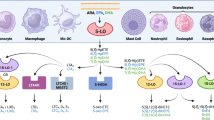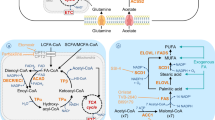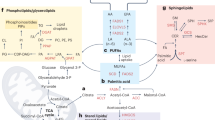Abstract
Discovery of molecular pathways critical to carcinogenesis is revolutionizing the treatment and prevention of cancer. Traditional chemotherapeutic approaches usually cause 'global' cytotoxicity to both normal and carcinoma cells. Over the past decade, however, investigators have developed compounds that inhibit tumor formation more selectively by targeting specific signaling pathways, including those involving the epidermal growth factor receptor (EGFR) and cyclooxygenase 2 (COX2). COX2-derived bioactive lipids, including prostaglandin E2, are potent inflammatory mediators that promote tumor growth and metastasis through stimulation of cell proliferation, invasion, and angiogenesis. Recent work has demonstrated significant crosstalk between the COX2 and EGFR pathways, while preclinical data demonstrates a synergistic effect when both pathways are targeted simultaneously. Combination therapy, a common strategy in cancer treatment, is likely to improve outcomes in cancer prevention as well. Ongoing clinical trials designed to assess whether low doses of COX2 and EGFR inhibitors used in combination could prove more effective and result in reduced toxicity than either agent alone may provide new options for cancer prevention and treatment. We discuss advances in cancer prevention by focusing on mechanisms by which bioactive lipids contribute to tumor formation. While cancer chemoprevention is a relatively young field, we argue that this approach to malignant disease bears significant potential.
This is a preview of subscription content, access via your institution
Access options
Subscribe to this journal
Receive 12 print issues and online access
$209.00 per year
only $17.42 per issue
Buy this article
- Purchase on Springer Link
- Instant access to full article PDF
Prices may be subject to local taxes which are calculated during checkout


Similar content being viewed by others
References
Edwards BK et al. (2002) Annual report to the nation on the status of cancer, 1973–1999, featuring implications of age and aging on US cancer burden. Cancer 94: 2766–2792
Sporn MB (1976) Approaches to prevention of epithelial cancer during the preneoplastic period. Cancer Res 36 (Pt 2): 2699–2702
Sabichi AL et al. (2003) Frontiers in cancer prevention research. Cancer Res 63: 5649–5655
Sudbo J et al. (2001) DNA content as a prognostic marker in patients with oral leukoplakia. N Engl J Med 344: 1270–1278
Fisher B et al. (1998) Tamoxifen for prevention of breast cancer: report of the National Surgical Adjuvant Breast and Bowel Project P-1 Study. J Natl Cancer Inst 90: 1371–1388
Steinbach G et al. (2000) The effect of celecoxib, a cyclooxygenase-2 inhibitor, in familial adenomatous polyposis. N Engl J Med 342: 1946–1952
Tsao AS et al. (2004) Chemoprevention of cancer. CA Cancer J Clin 54: 150–180
Saltz LB et al. (2000) Irinotecan plus fluorouracil and leucovorin for metastatic colorectal cancer. Irinotecan Study Group. N Engl J Med 343: 905–914
Eberhart CE et al. (1994) Up-regulation of cyclooxygenase-2 gene expression in human colorectal adenomas and adenocarcinomas. Gastroenterology 107: 1183–1188
Gupta RA and DuBois RN (2001) Colorectal cancer prevention and treatment by inhibition of cyclooxygenase-2. Nat Rev Cancer 1: 11–21
Marnett LJ and DuBois RN (2002) COX-2: A target for colon cancer prevention. Annu Rev Pharmacol Toxicol 42: 55–80
Vane JR (1971) Inhibition of prostaglandin synthesis as a mechanism of action for aspirin-like drugs. Nature 231: 232–235
Shureiqi I et al. (2000) 15-Lipoxygenase-1 mediates nonsteroidal anti-inflammatory drug-induced apoptosis independently of cyclooxygenase-2 in colon cancer cells. Cancer Res 60: 6846–6850
Benamouzig R et al. (2003) Daily soluble aspirin and prevention of colorectal adenoma recurrence: one-year results of the APACC trial. Gastroenterology 125: 328–336
Smalley WE and DuBois RN (1997) Colorectal cancer and nonsteroidal anti-inflammatory drugs. Adv Pharmacol 39: 1–20
Thun MJ et al. (1991) Aspirin use and reduced risk of fatal colon cancer. N Engl J Med 325: 1593–1596
Sandler RS et al. (2003) A randomized trial of aspirin to prevent colorectal adenomas in patients with previous colorectal cancer. N Engl J Med 348: 883–890
Baron JA et al. (2003) A randomized trial of aspirin to prevent colorectal adenomas. N Engl J Med 348: 891–899
DuBois RN et al. (1996) Nonsteroidal anti-inflammatory drugs, eicosanoids and colorectal cancer prevention. Gastroenterol Clin North Am 25: 773–791
Giardiello FM et al. (1993) Treatment of colonic and rectal adenomas with sulindac in familial adenomatous polyposis. N Engl J Med 328: 1313–1316
Labayle D et al. (1991) Sulindac causes regression of rectal polyps in familial adenomatous polyposis. Gastroenterology 101: 635–639
Steinbach G et al. (2000) The effect of celecoxib, a cyclooxygenase-2 inhibitor, in familial adenomatous polyposis. N Engl J Med 342: 1946–1952
Giardiello FM et al. (2002) Primary chemoprevention of familial adenomatous polyposis with sulindac. N Engl J Med 346: 1054–1059
Wolfe MM et al. (1999) Gastrointestinal toxicity of nonsteroidal antiinflammatory drugs. N Engl J Med 340: 1888–1899
Taha AS et al. (1996) Famotidine for the prevention of gastric and duodenal ulcers caused by nonsteroidal antiinflammatory drugs. N Engl J Med 334: 1435–1439
Laine L et al. (1999) A randomized trial comparing the effect of rofecoxib, a cyclooxygenase 2-specific inhibitor, with that of ibuprofen on the gastroduodenal mucosa of patients with osteoarthritis. Rofecoxib Osteoarthritis Endoscopy Study Group. Gastroenterology 117: 776–783
Bombardier C et al. (2000) Comparison of upper gastrointestinal toxicity of rofecoxib and naproxen in patients with rheumatoid arthritis. VIGOR Study Group. N Engl J Med 343: 1520–1528
Grover JK et al. (2003) Cyclo-oxygenase 2 inhibitors: emerging roles in the gut. Int J Colorectal Dis 18: 279–291
Hernandez MR et al. (2004) Evaluation of effects of rofecoxib on platelet function in an in vitro model of thrombosis with circulating human blood. Eur J Clin Invest 34: 297–302
Brinker A et al. (2004) Spontaneous reports of hypertension leading to hospitalisation in association with rofecoxib, celecoxib, nabumetone and oxaprozin. Drugs Aging 21: 479–484
Kimmel SE et al. (2005) Patients exposed to rofecoxib and celecoxib have different odds of nonfatal myocardial infarction. Ann Intern Med 142: 157–164
Bresalier R et al. (2004) Rofecoxib APPROVe Study Results and Their Implications. In 2004 ACR/ARHP Annual Scientific Meeting: 2004; October 16–21; Texas
Silverstein FE et al. (2000) Gastrointestinal toxicity with celecoxib vs nonsteroidal anti-inflammatory drugs for osteoarthritis and rheumatoid arthritis: the CLASS study: A randomized controlled trial. Celecoxib Long-term Arthritis Safety Study. JAMA 284: 1247–1255
Tortora G et al. (2003) Combination of a selective cyclooxygenase-2 inhibitor with epidermal growth factor receptor tyrosine kinase inhibitor ZD1839 and protein kinase A antisense causes cooperative antitumor and antiangiogenic effect. Clin Cancer Res 9: 1566–1572
Torrance CJ et al. (2000) Combinatorial chemoprevention of intestinal neoplasia. Nature Med 6: 1024–1028
Baselga J et al. (2002) Phase I safety, pharmacokinetic, and pharmacodynamic trial of ZD1839, a selective oral epidermal growth factor receptor tyrosine kinase inhibitor, in patients with five selected solid tumor types. J Clin Oncol 20: 4292–4302
Rigas B et al. (1993) Altered eicosanoid levels in human colon cancer. J Lab Clin Med 122: 518–523
Turini ME and DuBois RN (2002) Cyclooxygenase-2: a therapeutic target. Annu Rev Med 53: 35–57
Hansen-Petrik MB et al. (2002) Prostaglandin E(2) protects intestinal tumors from nonsteroidal anti-inflammatory drug-induced regression in Apc(Min/+) mice. Cancer Res 62: 403–408
Kawamori T et al. (2003) Enhancement of colon carcinogenesis by prostaglandin E2 administration. Carcinogenesis 24: 985–990
Wang D et al. (2004) Prostaglandin E(2) promotes colorectal adenoma growth via transactivation of the nuclear peroxisome proliferator-activated receptor delta. Cancer Cell 6: 285–295
Watanabe K et al. (1999) Role of the prostaglandin E receptor subtype EP1 in colon carcinogenesis. Cancer Res 59: 5093–5096
Mutoh M et al. (2002) Involvement of prostaglandin E receptor subtype EP(4) in colon carcinogenesis. Cancer Res 62: 28–32
Sonoshita M et al. (2001) Acceleration of intestinal polyposis through prostaglandin receptor EP2 in Apc (Delta 716) knockout mice. Nat Med 7: 1048–1051
Quidville V et al. (2004) Tumor growth inhibition by indomethacin in a mouse model of human medullary thyroid cancer: implication of cyclooxygenases and 15-hydroxyprostaglandin dehydrogenase. Endocrinology 145: 2561–2571
Gee JR et al. (2003) Cytokeratin 20, AN43, PGDH, and COX-2 expression in transitional and squamous cell carcinoma of the bladder. Urol Oncol 21: 266–270
Backlund MG et al. (2005) 15-hydroxyprostaglandin dehydrogenase is downregulated in colorectal cancer. J Biol Chem 280: 3217–3223
Davis TW et al. (2004) Synergy between celecoxib and radiotherapy results from inhibition of cyclooxygenase-2-derived prostaglandin E2, a survival factor for tumor and associated vasculature. Cancer Res 64: 279–285
Liu W et al. (2003) Combination of radiation and celebrex (celecoxib) reduce mammary and lung tumor growth. Am J Clin Oncol 26: S103–S109
Rich TA and Shepard R (2003) COX-2 inhibitors as radiation sensitizers for upper GI tract cancers: esophagus, stomach, and pancreas. Am J Clin Oncol 26: S110–S113
Solomon SD et al. (2005) Cardiovascular risk associated with celecoxib in a clinical trial for colorectal adenoma prevention. N Engl J Med [10.1056/NEJMoa050405]
Bresalier RS et al. (2005) Cardiovascular events associated with rofecoxib in a colorectal adenoma chemoprevention trial. N Engl J Med [10.1056/NEJMoa050493]
Nussmeier NA et al. (2005) Complications of the COX-2 Inhibitors parecoxib and valdecoxib after cardiac surgery. N Engl J Med [10.1056/NEJMoa050330]
Gann PH et al. (1993) Low-dose aspirin and incidence of colorectal tumors in a randomized trial. J Natl Cancer Inst 85: 1220–1224
Ladenheim J et al. (1995) Effect of sulindac on sporadic colonic polyps. Gastroenterology 108: 1083–1087
Acknowledgements
We acknowledge support from the United States Public Health Services Grants RO-DK-62112 and PO-CA77839. R DuBois is the Hortense B. Ingram Professor of Molecular Oncology and the recipient of an NIH MERIT award (R37-DK47297). We are grateful to the TJ Martell Foundation and the National Colorectal Cancer Research Alliance (NCCRA) for generous support.
Author information
Authors and Affiliations
Corresponding author
Ethics declarations
Competing interests
The authors declare no competing financial interests.
Glossary
- PRIMARY PREVENTION
-
Prevention of tumor formation in otherwise healthy patients
- SECONDARY PREVENTION
-
Prevention of progression from premalignant lesion to invasive cancer
- TERTIARY PREVENTION
-
Prevention of second primary tumor formation in patients cured of their initial tumor
- SECOND PRIMARY TUMORS
-
Neoplasia developing from genetically related dysplastic epithelium bordering areas of fully invasive neoplasia. These tumours typically arise following successful removal of the first primary tumor and are associated with high mortality rates
- HISTAMINE 2 RECEPTOR ANTAGONISTS
-
Histamine 2 receptor antagonists are used to block the action of histamine on parietal cells in the stomach, decreasing production of gastric acid
- PROTON-PUMP INHIBITORS
-
Reduce the production of acid by irreversibly blocking the hydrogen-potassium adenosine triphosphatase enzyme, thereby limiting acid production in the stomach
- THERAPEUTIC RATIO
-
This defines the difference between a minimum therapeutically effective dose and a maximum dose capable of inducing intolerable side effects; the difference between the minimum and maximum effective doses. Also known as the therapeutic window
- AZOXYMETHANE
-
A potent carcinogen used to induce colon cancer in rats and mice
Rights and permissions
About this article
Cite this article
Mann, J., Backlund, M. & DuBois, R. Mechanisms of Disease: inflammatory mediators and cancer prevention. Nat Rev Clin Oncol 2, 202–210 (2005). https://doi.org/10.1038/ncponc0140
Received:
Accepted:
Issue Date:
DOI: https://doi.org/10.1038/ncponc0140
This article is cited by
-
Tea polyphenols attenuate liver inflammation by modulating obesity-related genes and down-regulating COX-2 and iNOS expression in high fat-fed dogs
BMC Veterinary Research (2020)
-
Cross-talk between SIM2s and NFκB regulates cyclooxygenase 2 expression in breast cancer
Breast Cancer Research (2019)
-
Apoptosis-inducing activities of Halopteris scoparia L. Sauvageau (Brown algae) on cancer cells and its biosafety and antioxidant properties
Cytotechnology (2019)
-
Inhibitory Effect of Ficin Derived from Fig Latex on Inflammation and Melanin Production in Skin Cells
Biotechnology and Bioprocess Engineering (2019)
-
Protective effect of acacetin on sepsis-induced acute lung injury via its anti-inflammatory and antioxidative activity
Archives of Pharmacal Research (2018)



